




 |
 |
 |
 |
 |
DEVELOPMENT |
ONLINE
PROJECTS |
|||||
USEFUL EQUIPMENT |
| Equipment for making & colouring Encaustic Wax Medium | |
|
|
|
Temperature controllable vessels are the main consideration in this section. But what other equipment might be needed to safely make your own encaustic medium? No answers on a post card please, just read this and you will at least discover what we have found helpful in our efforts. Making encaustic medium means you define the conten. You can alter the nature of the wax you use. Once you have the raw ingredients molten, mixed and cast, then you will also need to use heated devices to re-melt and maintain the liquid state whilst colours are added and, in some approaches, whilst the encaustic paint is used. |
So here are some items of equipment that may
prove useful as you work forward ... |
|
|
 A wax thermometer is available from candle maker suppliers and is graded for wax usage. Perhaps worth having if you are going to do bigger mixes to understand & control more exact temperatures. |
 |
Burco Double Boiler. This is a commercial water heating boiler complete with dispensing tap, often used in catering situations. The central container sits inside the main boiler vessel which will have been filled with sufficient water to create a liquid jacket around the inner container when it is in place. The element then heats the water which indirectly heats the inner container of wax. It is the safest way to melt wax without any danger of over-heating. |
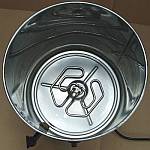 |
The element is situated at the base of the main vessel; a powerful electrical heating ring. These boilers are often used to heat water in this main vessel chamber for making tea and coffee at events. The stainless steel is easy to clean, but it is always advisable to empty out any water once you have finished using the boiler. NEVER LEAVE ELECTRICAL HEATED EQUIPMENT UNATTENDED |
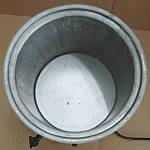 |
The inner aluminum container can be affected by unsightly corrosion if left in water, so always remove and dry it once you are done. Wax can be left to cool in this container, to be heated at a future time. However, there is no way you will get the wax out of there without re-melting it! It is best not to over-fill this container - half full is plenty! |
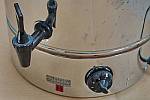 |
Finally, you see the tap for the dispensing and removal of water. The thermostat below on the right has a number of settings. It works well if you put it on full to get the temperature up quickly, then turn down to a holding temperature that suits the waxes you are melting. |
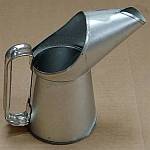 |
Various jugs are available for decanting and pouring the wax into molds. This tine one is light and small - ideal for pouring the molten wax into small molds. Metal jugs or handled containers are good because they can be sat on a hotplate to remain warmed for longer if required. |
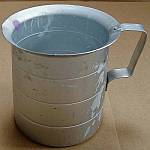 |
Bigger containers, like this aluminum jug, can be useful for dividing the wax into separate quantities, perhaps for colour mixing, or to then treat one portion with extra ingredients. Aluminum is not the cleanest of metals, but for this work it is fine. |
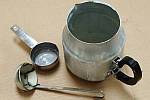 |
Other smaller decanting containers can be small domestic things, like this old tea pot, or the stainless steel measuring spoon or the kitchen ladle. |
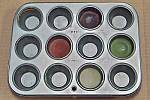 |
There are all sort of molds to be found. This one is a domestic cake tin designed to create small muffins or tea cakes perhaps. The wells are a good size for small individual colours. The resultant cakes of wax can be kept in these wells, but the angle and non-stick coating make it easy to get them out once cool. If stubborn just put the whole thing in the freezer for 15 minutes. |
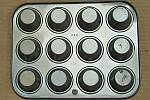 |
Underneath the muffin tin has flat bottomed areas. These are ideal for sitting on a hotplate where they can be kept warm. For colour mixing or a working molten palette this is excellent. |
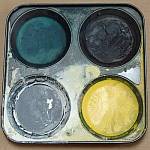 |
Larger pan sizes of similar flat bottomed domestic cooking tins are also available. These pie or small tart tins offer good volume in the wells and also have spaces between where colours can be mixed. |
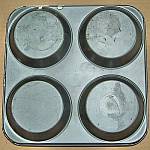 |
The wide flat bottomed wells take heat easily from the hotplate and work beautifully as heated palette containers. |
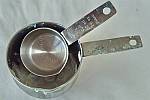 |
Small stainless steel measuring cups often look like minute saucepans. A whole set of these costs very little from the home baking section of a super market. Their flat bottoms make them great for small quantity melting and colour mixings. |
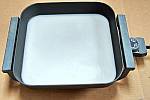 |
The domestic skillet is an handled dish-like container used for various types of cooking. The temperature is controllable on the better ones - always go for that as your priority. |
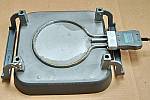 |
This one has a single electrical element heater just attached to the underside of the metal dish. The legs keep it all supported off the ground. The thermostatically controlled power source plugs in from the right side here |
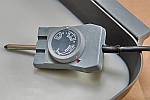 |
The probe on the thermostat is now visible. It monitors the temperature and the dial enables adjustment of the selected heat setting. Remember; if wax smokes it is already too hot. Turn it down immediately. Always ensure good ventilation when in operation. |
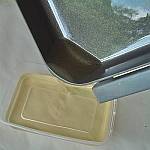 |
Pouring wax out from the skillet is easy so long as your molds are a reasonable size. Use padded gloves or protective fabric to hold the hot metal container as you pour. |
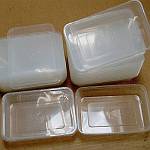 |
Take-away or "to go" boxes are ideal molds. These ones are microwave containers suitable for hot foods and are ideal for larger block wax molds. The lids can be fitted after cooling to ensure that the product remains in perfect condition until you are ready to use it, even years later. |
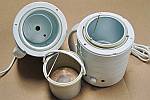 |
There are specific wax melt pots available, often used by the cosmetic salons for melting the wax used in hair removal - leg waxing, etc. They usually have a removable inner bucket and the thermostats are designed for all day use, so are very good. |
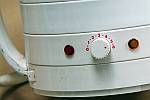 |
Often, like this example, there are lights that indicate when the unit is switched on and heating, and also when it has arrived at the desired temperature. The thermostatic dial usually allows selection of a variety of temperatures so as to accommodate different wax blends and their respective temperatures.
|
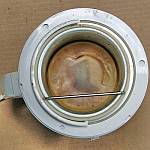 |
Looking down into the pot as the wax starts to melt. The plastic semi-circle in white is the folded down handle whilst the cross bar is designed to allow tools to be rested over the container so that drips land appropriately. When the wax is solidified in this container there is no way you will get it out except by remelting! |
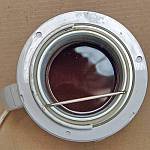 |
... and so here is the same wax now in molten form, ready for pouring of direct usage. Although these units are designed to be used all day long in salons it is advisable never to leave electrically heated apparatus unattended, just in case there is any problem with electrical supply or even product breakdown. It is just a sensible routine for safe operation. |
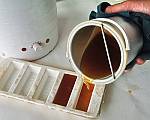 |
The white handle is now visible, but pouring is easier in this case by using a cloth to hold the container. Pouring is more controlled for the small molds being filled here. The container should be cleaned by wiping with tissue whilst still warm. Obviously, do this with care or you could burn your hand! |
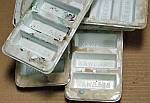 |
Beeswax molds are available from any good beekeepers supplies source. These white plastic molds are 2oz size which is a very convenient piece of wax to work with. The molds are ideal for pouring the final coloured waxes into for this reason. |
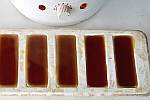 |
So the molten wax has been poured out of the wax pot into the beeswax 2oz molds. These can be used over and over. |
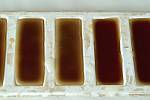 |
As the wax cools it changes colour, congealing into a cloudier visual quality than when it was molten. This shows the base colour and transparency qualities of your particular wax mixture. |
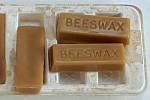 |
Once cool the wax will shrink slightly, making it fairy easy to pop out of the flexible plastic molds. One tip to speed this up is to put the molds in a cold place, even a freezer for a few minutes will work well. The wax pieces can now be re-melted for addition of colour, stored just as they are or used as medium to extend or interact with other coloured waxes, etc. |
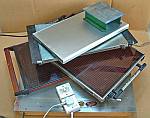 |
Hotplates are found in a multitude of sizes and temperature ranges. Scientific ones can be very accurate whilst some domestic ones have no real variation of temperature available and have been designed to keep food hot. These can get way to hot for wax use, so check carefully before investing. |
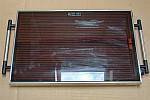 |
Fortunately there are quite a few hotplates, like this one shown, that are ideal for wax work. A hotplate can be used for many painting techniques. This is the A2+ Ultimate Hotplate with a glass top for easy cleaning, a high quality thermostat for accurate control of temperature, handles for easy movement even whilst hot and so on. |
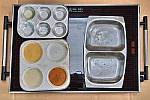 |
A hotplate can be used to host mixing metal palettes like these baking tins or serving trays. Of course, the waxes can also be mixed directly onto the hotplate surface for small amounts. |
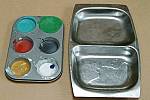 |
Baking tins, muffin tins, stainless steel serving vessels and so on all make potentially useful items for mixing and active use palettes. Waxes can be left to go cold, then easily re-heated. Muffin tins have
a good rake (angle) on the wells, so it is often quite easy to release
the cold hard wax disks from these too. |
Go to CAUTIONS or perhaps
the ARTWORK INDEX |
|
|